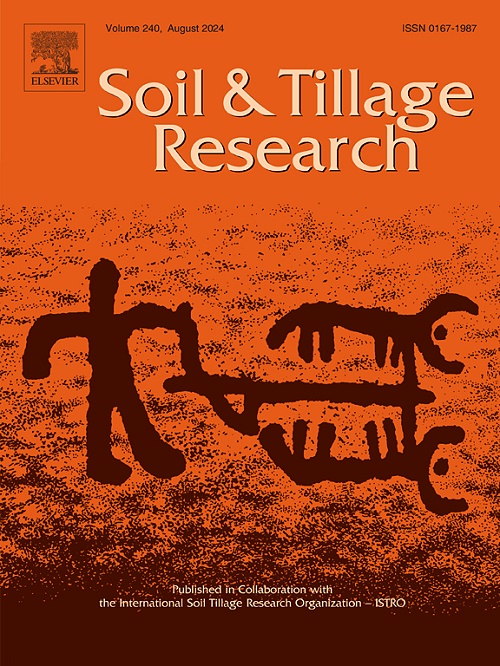Soil physical quality using DRES and VESS visual assessment approaches and physical properties
IF 6.1
1区 农林科学
Q1 SOIL SCIENCE
引用次数: 0
Abstract
Soil structure evaluation is one of the main tools for diagnosing changes in soil physical quality under contrasting land-use systems. Visual assessment methods have been proposed as a low cost and practical alternative to traditional methods for evaluating soil structural quality. The Rapid Diagnosis of Soil Structure (DRES) is one of the most recent visual methods proposed for assessing the structural condition of tropical soils. It is supposed to improve on other methods by setting a lower soil aggregates diameter limit for soils with good structural quality. There are few publications which assess its performance and correspondence to other soil physical properties. Thus, this study evaluated the structural quality of an Oxisol (Typic Haplustox) under pasture system (PS), silage corn under direct seeding (DS), banana orchard (BA) and native vegetation Cerrado (CN) using the DRES methodology. In addition, we correlated the scores of the visual analysis with the soil physical properties bulk density (BD), total porosity (TP), soil penetration resistance (SPR), soil penetration resistance corrected to the field capacity (SPRFC), weighted average diameter of aggregates (WAD), soil organic matter (OM) and parameters of the water retention curve (WRC). A comparison was also made between DRES and the Visual Evaluation of Soil Structure (VESS) methodology. The soil under PS and DS showed the lowest scores for the DRES, and consequently the worst structural soil quality condition. The physical properties BD, TP, SPR, microporosity (MICRO) and macroporosity (MACRO) showed significant correlation with the visual analysis scores obtained using DRES and VESS. In general, DRES distinguished the soil structural quality under different land-use systems and can be considered a promising semi-quantitative method in diagnosing soil structural quality. However, even though DRES and VESS scored similarly in this study, there are possible critical incompatibilities between the two systems regarding diameter of aggregates that need to be addressed in further studies.
利用DRES和VESS对土壤物理质量进行目视评价
土壤结构评价是诊断不同土地利用制度下土壤物理质量变化的主要工具之一。目测评价方法被认为是一种低成本、实用的土壤结构质量评价方法。土壤结构快速诊断(DRES)是最近提出的用于评估热带土壤结构状况的可视化方法之一。对于结构质量较好的土,应在其他方法的基础上进行改进,设定较低的土团聚体直径限值。很少有出版物评估其性能和与其他土壤物理性质的对应关系。因此,本研究采用DRES方法评价了牧草系统(PS)下的Oxisol (Typic Haplustox)、直接播种青贮玉米(DS)、香蕉果园(BA)和原生植被Cerrado (CN)的结构质量。此外,我们还将视觉分析得分与土壤物理特性(容重(BD)、总孔隙度(TP)、土壤渗透阻力(SPR)、土壤渗透阻力修正到田间容量(SPRFC)、团聚体加权平均直径(WAD)、土壤有机质(OM)和保水曲线(WRC)参数进行了相关性分析。并将DRES与土壤结构目视评价(VESS)方法进行了比较。PS和DS处理下的土壤DRES得分最低,因此结构土质量状况最差。物理性质BD、TP、SPR、微孔隙度(MICRO)和宏观孔隙度(MACRO)与DRES和VESS可视化分析得分呈显著相关。总的来说,DRES能够区分不同土地利用制度下的土壤结构质量,是一种很有前途的半定量诊断方法。然而,尽管DRES和VESS在本研究中的得分相似,但在聚集体直径方面,两种系统之间可能存在严重的不相容性,需要在进一步的研究中加以解决。
本文章由计算机程序翻译,如有差异,请以英文原文为准。
求助全文
约1分钟内获得全文
求助全文
来源期刊

Soil & Tillage Research
农林科学-土壤科学
CiteScore
13.00
自引率
6.20%
发文量
266
审稿时长
5 months
期刊介绍:
Soil & Tillage Research examines the physical, chemical and biological changes in the soil caused by tillage and field traffic. Manuscripts will be considered on aspects of soil science, physics, technology, mechanization and applied engineering for a sustainable balance among productivity, environmental quality and profitability. The following are examples of suitable topics within the scope of the journal of Soil and Tillage Research:
The agricultural and biosystems engineering associated with tillage (including no-tillage, reduced-tillage and direct drilling), irrigation and drainage, crops and crop rotations, fertilization, rehabilitation of mine spoils and processes used to modify soils. Soil change effects on establishment and yield of crops, growth of plants and roots, structure and erosion of soil, cycling of carbon and nutrients, greenhouse gas emissions, leaching, runoff and other processes that affect environmental quality. Characterization or modeling of tillage and field traffic responses, soil, climate, or topographic effects, soil deformation processes, tillage tools, traction devices, energy requirements, economics, surface and subsurface water quality effects, tillage effects on weed, pest and disease control, and their interactions.
 求助内容:
求助内容: 应助结果提醒方式:
应助结果提醒方式:


